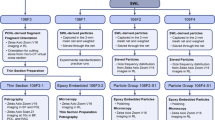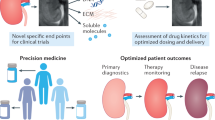Abstract
Nephrolithiasis, or stones, is one of the oldest urological diseases, with descriptions and treatment strategies dating back to ancient times. Despite the enormous number of patients affected by stones, a surprising lack of conceptual understanding of many aspects of this disease still exists. This lack of understanding includes mechanisms of stone formation and retention, the clinical relevance of different stone compositions and that of formation patterns and associated pathological features to the overall course of the condition. Fortunately, a number of new tools are available to assist in answering such questions. New renal endoscopes enable kidney visualization in much higher definition than was previously possible, while micro-CT imaging is the optimal technique for assessment of stone microstructure and mineral composition in a nondestructive fashion. Together, these tools have the potential to provide novel insights into the aetiology of stone formation that might unlock new prevention and treatment strategies, and enable more effective management of patients with nephrolithiasis.
This is a preview of subscription content, access via your institution
Access options
Subscribe to this journal
Receive 12 print issues and online access
$209.00 per year
only $17.42 per issue
Buy this article
- Purchase on Springer Link
- Instant access to full article PDF
Prices may be subject to local taxes which are calculated during checkout







Similar content being viewed by others
References
Kirkali, Z., Rasooly, R., Star, R. A. & Rodgers, G. P. Urinary Stone disease: progress, status, and needs. Urology 86, 651–653 (2015).
Pearle, M. S. et al. Medical management of kidney stones: AUA guideline. J. Urol. 192, 316–324 (2014).
Turk, C. et al. EAU guidelines on interventional treatment for urolithiasis. Eur. Urol. 69, 475–482 (2015).
Cloutier, J., Villa, L., Traxer, O. & Daudon, M. Kidney stone analysis: “Give me your stone, I will tell you who you are!”. World J. Urol. 33, 157–169 (2015).
Sharma, R. N., Shah, I., Gupta, S., Sharma, P. & Beigh, A. A. Thermogravimetric analysis of urinary stones. Br. J. Urol. 64, 564–566 (1989).
Fazil Marickar, Y. M., Lekshmi, P. R., Varma, L. & Koshy, P. EDAX versus FTIR in mixed stones. Urol. Res. 37, 271–276 (2009).
Bastian, P. J., Lorken, M., Euler, H., Lummen, G. & Bastian, H. P. [Results of the evaluation of 85,337 urinary stone analyses]. Aktuelle Urol. 39, 298–304 (in German) (2008).
Daudon, M., Protat, M. F., Reveillaud, R. J. & Jaeschke-Boyer, H. Infrared spectrometry and Raman microprobe in the analysis of urinary calculi. Kidney Int. 23, 842–850 (1983).
Daudon, M. et al. Sex- and age-related composition of 10 617 calculi analyzed by infrared spectroscopy. Urol. Res. 23, 319–326 (1995).
Krambeck, A. E. et al. Inaccurate reporting of mineral composition by commercial stone analysis laboratories: implications for infection and metabolic stones. J. Urol. 184, 1543–1549 (2010).
McGuire, B. B. et al. Predicting patients with inadequate 24- or 48-hour urine collections at time of metabolic stone evaluation. J. Endourol. 29, 730–735 (2015).
Healy, K. A., Hubosky, S. G. & Bagley, D. H. 24-hour urine collection in the metabolic evaluation of stone formers: is one study adequate? J. Endourol. 27, 374–378 (2013).
Castle, S. M., Cooperberg, M. R., Sadetsky, N., Eisner, B. H. & Stoller, M. L. Adequacy of a single 24-hour urine collection for metabolic evaluation of recurrent nephrolithiasis. J. Urol. 184, 579–583 (2010).
Pak, C. Y., Peterson, R. & Poindexter, J. R. Adequacy of a single stone risk analysis in the medical evaluation of urolithiasis. J. Urol. 165, 378–381 (2001).
Parks, J. H., Goldfisher, E., Asplin, J. R. & Coe, F. L. A single 24-hour urine collection is inadequate for the medical evaluation of nephrolithiasis. J. Urol. 167, 1607–1612 (2002).
Nayan, M., Elkoushy, M. A. & Andonian, S. Variations between two 24-hour urine collections in patients presenting to a tertiary stone clinic. Can. Urol. Assoc. J. 6, 30–33 (2012).
Evan, A. P., Lingeman, J. E., McAteer, J. A. & Williams, J. C. Jr. Introduction to special issue on the Proceedings of the 3rd International Urolithiasis Research Symposium held in Indianapolis. Urol. Res. 38, 237 (2010).
Evan, A. P., Worcester, E. M., Coe, F. L., Williams, J. Jr & Lingeman, J. E. Mechanisms of human kidney stone formation. Urolithiasis 43 (Suppl. 1), 19–32 (2015).
Coe, F. L., Evan, A. P., Lingeman, J. E. & Worcester, E. M. Plaque and deposits in nine human stone diseases. Urol. Res. 38, 239–247 (2010).
Rassweiler, J., Rassweiler, M. C. & Klein, J. New technology in ureteroscopy and percutaneous nephrolithotomy. Curr. Opin. Urol. 26, 95–106 (2016).
Borofsky, M. S. & Shah, O. Advances in ureteroscopy. Urol. Clin. North Am. 40, 67–78 (2013).
Andonian, S., Okeke, Z. & Smith, A. D. Digital ureteroscopy: the next step. J. Endourol. 22, 603–606 (2008).
Humphreys, M. R. et al. A new world revealed: early experience with digital ureteroscopy. J. Urol. 179, 970–975 (2008).
Zilberman, D. E. et al. The digital flexible ureteroscope: in vitro assessment of optical characteristics. J. Endourol. 25, 519–522 (2011).
Flachenecker, G. & Fastenmeier, K. High frequency current effects during transurethral resection. J. Urol. 122, 336–341 (1979).
Somani, B. K., Al-Qahtani, S. M., de Medina, S. D. & Traxer, O. Outcomes of flexible ureterorenoscopy and laser fragmentation for renal stones: comparison between digital and conventional ureteroscope. Urology 82, 1017–1019 (2013).
Multescu, R., Geavlete, B., Georgescu, D. & Geavlete, P. Improved durability of flex-Xc digital flexible ureteroscope: how long can you expect it to last? Urology 84, 32–35 (2014).
Borofsky, M. S. et al. A proposed grading system to standardize the description of renal papillary appearance at the time of endoscopy in patients with nephrolithiasis. J. Endourol. 30, 122–127 (2016).
Low, R. K. & Stoller, M. L. Endoscopic mapping of renal papillae for Randall's plaques in patients with urinary stone disease. J. Urol. 158, 2062–2064 (1997).
Linnes, M. P. et al. Phenotypic characterization of kidney stone formers by endoscopic and histological quantification of intrarenal calcification. Kidney Int. 84, 818–825 (2013).
Evan, A., Lingeman, J., Coe, F. L. & Worcester, E. Randall's plaque: pathogenesis and role in calcium oxalate nephrolithiasis. Kidney Int. 69, 1313–1318 (2006).
Miller, N. L. et al. A formal test of the hypothesis that idiopathic calcium oxalate stones grow on Randall's plaque. BJU Int. 103, 966–971 (2009).
Matlaga, B. R. et al. Endoscopic evidence of calculus attachment to Randall's plaque. J. Urol. 175, 1720–1724; discussion 1724 (2006).
Jaeger, C. D. et al. Endoscopic and pathologic characterization of papillary architecture in struvite stone formers. Urology 90, 39–44 (2016).
Viers, B. R. et al. Endoscopic and histologic findings in a cohort of uric acid and calcium oxalate stone formers. Urology 85, 771–776 (2015).
Evan, A. E. et al. Histopathology and surgical anatomy of patients with primary hyperparathyroidism and calcium phosphate stones. Kidney Int. 74, 223–229 (2008).
Evan, A. P. et al. Renal intratubular crystals and hyaluronan staining occur in stone formers with bypass surgery but not with idiopathic calcium oxalate stones. Anat. Rec. 291, 325–334 (2008).
Evan, A. P. et al. Renal crystal deposits and histopathology in patients with cystine stones. Kidney Int. 69, 2227–2235 (2006).
Evan, A. P. et al. Renal histopathology of stone-forming patients with distal renal tubular acidosis. Kidney Int. 71, 795–801 (2007).
Evan, A. P. et al. Intra-tubular deposits, urine and stone composition are divergent in patients with ileostomy. Kidney Int. 76, 1081–1088 (2009).
Evan, A. P. et al. Randall's plaque of patients with nephrolithiasis begins in basement membranes of thin loops of Henle. J. Clin. Invest. 111, 607–616 (2003).
Evan, A. P. et al. Crystal-associated nephropathy in patients with brushite nephrolithiasis. Kidney Int. 67, 576–591 (2005).
Evan, A. P. et al. Renal histopathology and crystal deposits in patients with small bowel resection and calcium oxalate stone disease. Kidney Int. 78, 310–317 (2010).
Evan, A. P. et al. Contrasting histopathology and crystal deposits in kidneys of idiopathic stone formers who produce hydroxy apatite, brushite, or calcium oxalate stones. Anat. Rec. 297, 731–748 (2014).
Evan, A. P. et al. Biopsy proven medullary sponge kidney: clinical findings, histopathology, and role of osteogenesis in stone and plaque formation. Anat. Rec. 298, 865–877 (2015).
Randall, A. The origin and growth of renal calculi. Ann. Surg. 105, 1009–1027 (1937).
Kim, S. C. et al. Stone formation is proportional to papillary surface coverage by Randall's plaque. J. Urol. 173, 117–119; discussion 119 (2005).
Williams, J. C. Jr, McAteer, J. A., Evan, A. P. & Lingeman, J. E. Micro-computed tomography for analysis of urinary calculi. Urol. Res. 38, 477–484 (2010).
Qu, M. et al. Dual-energy dual-source CT with additional spectral filtration can improve the differentiation of non-uric acid renal stones: an ex vivo phantom study. Am. J. Roentgenol. 196, 1279–1287 (2011).
Zarse, C. A. et al. Nondestructive analysis of urinary calculi using micro computed tomography. BMC Urol. 4, 15 (2004).
Pramanik, R., Asplin, J. R., Jackson, M. E. & Williams, J. C. Jr. Protein content of human apatite and brushite kidney stones: significant correlation with morphologic measures. Urol. Res. 36, 251–258 (2008).
Zarse, C. A. et al. Helical computed tomography accurately reports urinary stone composition using attenuation values: in vitro verification using high-resolution micro-computed tomography calibrated to fourier transform infrared microspectroscopy. Urology 63, 828–833 (2004).
Williams, J. C. et al. Progress in the use of helical CT for imaging urinary calculi. J. Endourol. 18, 937–941 (2004).
Kuo, R. L. et al. Endoscopic renal papillary biopsies: a tissue retrieval technique for histological studies in patients with nephrolithiasis. J. Urol. 170, 2186–2189 (2003).
Evan, A. P., Lingeman, J., Coe, F. L. & Worcester, E. Randall's plaque: pathogenesis and role in calcium oxalate nephrolithiasis. Kidney Int. 69, 1313–1318 (2006).
Williams, J. C. Jr & McAteer, J. A. Retention and growth of urinary stones—insights from imaging. J. Nephrol. 26, 25–31 (2013).
Borofsky, M. S. & Lingeman, J. E. The role of open and laparoscopic stone surgery in the modern era of endourology. Nat. Rev. Urol. 12, 392–400 (2015).
Borofsky, M. S. et al. A grading system for papillary injury in stone formers. In 33rd World Congress of Endourology (London, 2015).
Grapsa, D. & Ekaterini, P. Standardized categorical reporting of cytopathology results: the strengths and weaknesses of a constantly evolving and expanding system. Diagnost. Cytopathol. 41, 917–921 (2013).
Pancorbo-Hidalgo, P.L., Garcia-Fernandez, F.P., Lopez-Medina, I.M. & Alvarez-Nieto, C. Risk assessment scales for pressure ulcer prevention: a systematic review. J. Adv. Nurs. 54, 94–110 (2006).
Ajuied, A. et al. Anterior cruciate ligament injury and radiologic progression of knee osteoarthritis: a systematic review and meta-analysis. Am. J. Sports Med. 42, 2242–2252 (2014).
McGuire, B. B. & Fitzpatrick, J. M. The diagnosis and management of complex renal cysts. Curr. Opin. Urol. 20, 349–354 (2010).
Shenfeld, O. Z. & Gnessin, E. Management of urogenital trauma: state of the art. Curr. Opin. Urol. 21, 449–454 (2011).
Williams, J. C. et al. Micro-CT imaging of Randall's plaques. Urolithiasis 43 (Suppl. 1), 13–17 (2015).
Cifuentes Delatte, L., Hidalgo, A., Bellanato, J. & Santos, M. in Urinary Calculi: Recent Advances in Aetiology, Stone Structure and Treatment (eds Cifuentes Delatte, L., Rapado, A. & Hodgkinson, A.) 220–230 (S. Karger, 1973).
Schubert, G. & Brien, G. Crystallographic investigations of urinary calcium oxalate calculi. Int. Urol. Nephrol. 13, 249–260 (1981).
Acknowledgements
J.C.W., A.P.E. and J.E.L. gratefully acknowledge funding from the National Institutes of Health P01 DK056788/DK/NIDDK NIH HHS/United States.
Author information
Authors and Affiliations
Contributions
All authors made substantial contributions to researching data for this article, discussions of content, writing and editing and reviewing of this manuscript prior to submission.
Corresponding author
Ethics declarations
Competing interests
J.E.L. is the owner and scientific director of Beck Analytical and has acted as a consultant for Boston Scientific. The other authors declare no competing interests.
Rights and permissions
About this article
Cite this article
Borofsky, M., Dauw, C., Cohen, A. et al. Integration and utilization of modern technologies in nephrolithiasis research. Nat Rev Urol 13, 549–557 (2016). https://doi.org/10.1038/nrurol.2016.148
Published:
Issue Date:
DOI: https://doi.org/10.1038/nrurol.2016.148



